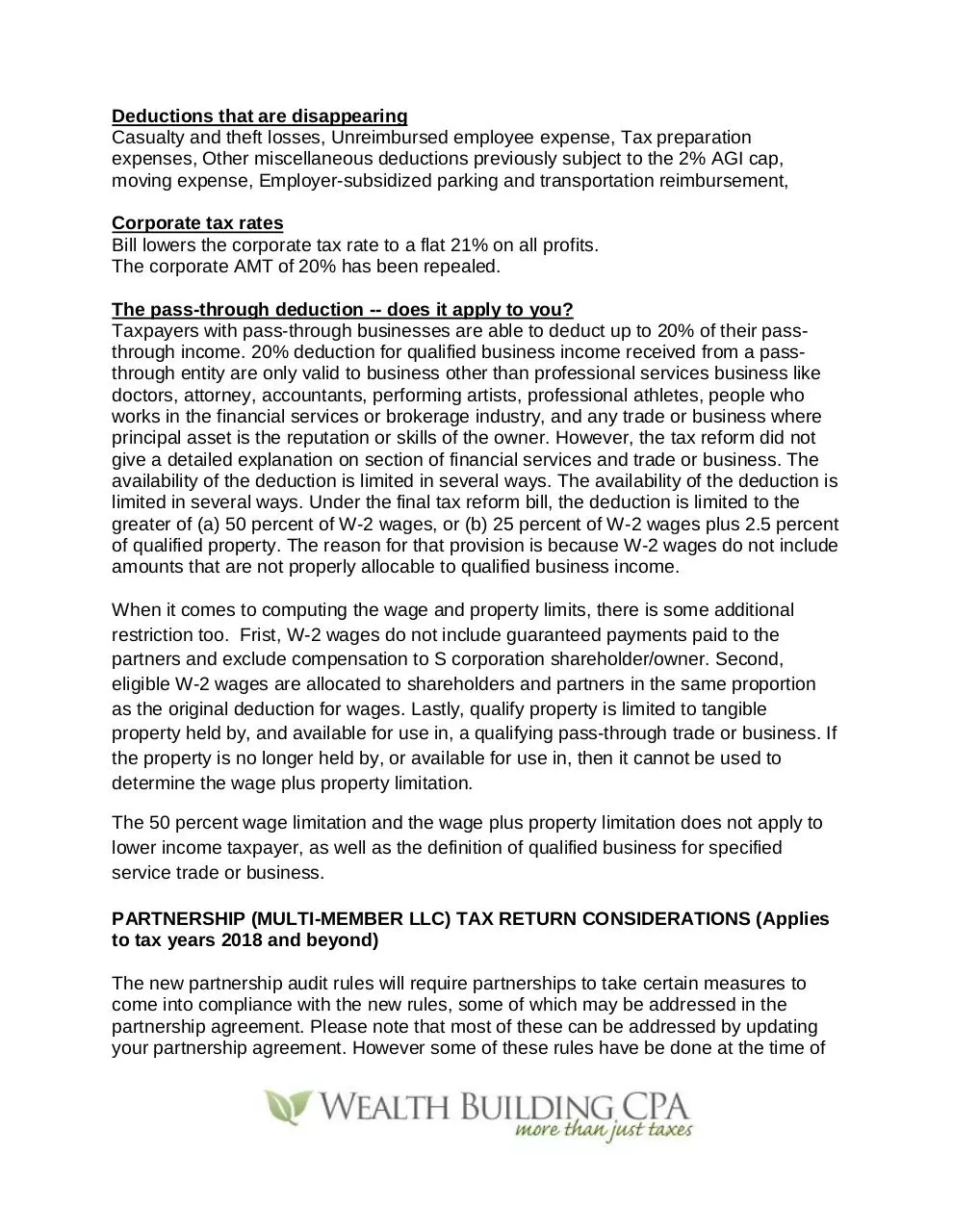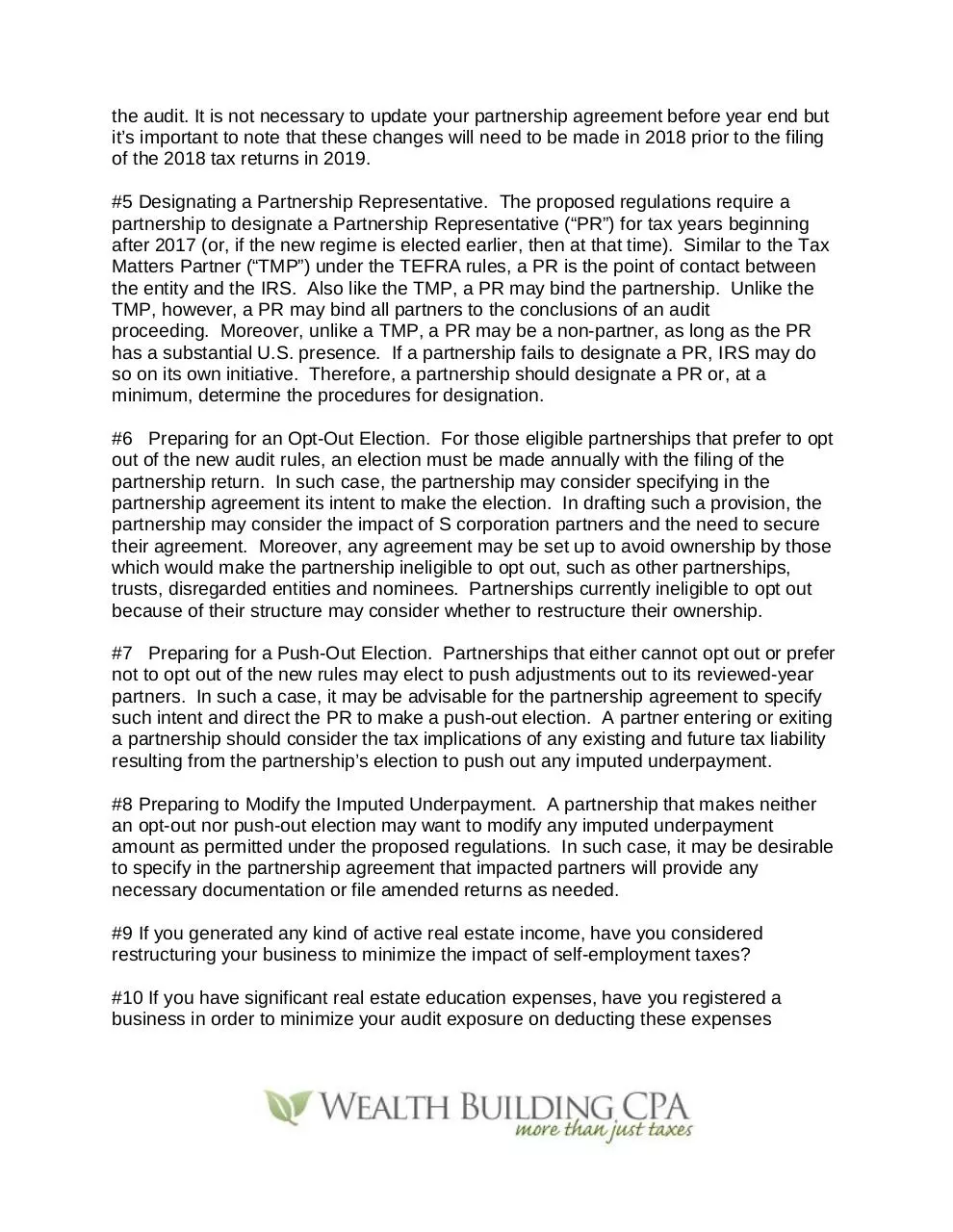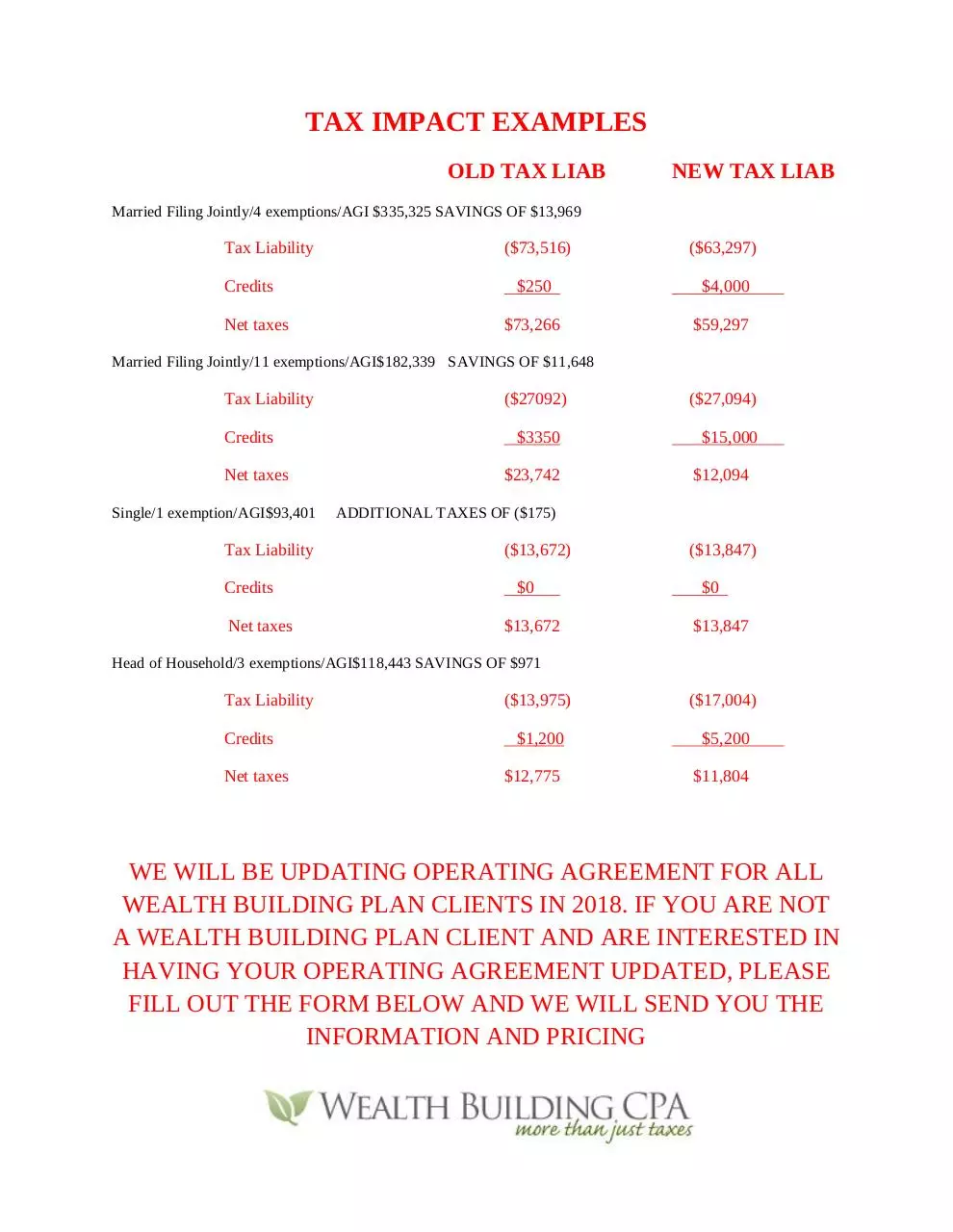TAX REFORM (PDF)
File information
Author: Staff
This PDF 1.5 document has been generated by Acrobat PDFMaker 11 for Word / Adobe PDF Library 11.0, and has been sent on pdf-archive.com on 12/01/2018 at 15:33, from IP address 131.118.x.x.
The current document download page has been viewed 724 times.
File size: 121.26 KB (5 pages).
Privacy: public file





File preview
2018 STRATEGIC TAX PLANNING
DON’T PAY UNCLE SAM MORE OF YOUR MONEY!!!
From the Desk of Ebere Okoye, The Wealthbuilding CPA
5010 Sunnyside Avenue, Ste 210, Beltsville, MD 20705.
Office: 301-441-4538, www.thewealthbuildingcpa.com, info@thewealthbuildingcpa.com
2018 tax brackets
1) Lowered marginal tax rate from 10%, 15%, 25%, 28%, 33%, 35%, 39.6%
To
10%, 12%, 22%, 24%, 32%, 35%, 37%.
Standard deduction and personal exemption
Personal exemption is eliminated but standard deductions are “doubled”
2018 Standard deduction:
Single ($12,000), Married Filing Jointly ($24,000), Married Filing Separately ($12,000)
Head of Household ($18,000)
Tax breaks for parents
Child tax credit changed from $1,000 to $2,000 and a refundable credit to $1,400.
New Phase-out threshold credit below: Married Filing jointly - $400,000, Individuals$200,000
In addition, if your children are 17 or older or you take care of elderly relatives, you can
claim a refundable $500 credit, subject to the same income thresholds.
Education tax breaks
People may use the funds in 529 for their child in private school or tutors in K-12 grade
levels.
Mortgage interest, charitable contributions, and medical expenses
Mortgage Interest Deduction: only valid for debt up to $750,000. And interest on the
home equity debt is not deductible anymore
Medical Expenses Deduction: Reduced from 10% AGI to the old 7.5% of AGI
The SALT deduction
Deduction only valid for amount to $10,000, including income, sales, and property taxes
Deductions that are disappearing
Casualty and theft losses, Unreimbursed employee expense, Tax preparation
expenses, Other miscellaneous deductions previously subject to the 2% AGI cap,
moving expense, Employer-subsidized parking and transportation reimbursement,
Corporate tax rates
Bill lowers the corporate tax rate to a flat 21% on all profits.
The corporate AMT of 20% has been repealed.
The pass-through deduction -- does it apply to you?
Taxpayers with pass-through businesses are able to deduct up to 20% of their passthrough income. 20% deduction for qualified business income received from a passthrough entity are only valid to business other than professional services business like
doctors, attorney, accountants, performing artists, professional athletes, people who
works in the financial services or brokerage industry, and any trade or business where
principal asset is the reputation or skills of the owner. However, the tax reform did not
give a detailed explanation on section of financial services and trade or business. The
availability of the deduction is limited in several ways. The availability of the deduction is
limited in several ways. Under the final tax reform bill, the deduction is limited to the
greater of (a) 50 percent of W-2 wages, or (b) 25 percent of W-2 wages plus 2.5 percent
of qualified property. The reason for that provision is because W-2 wages do not include
amounts that are not properly allocable to qualified business income.
When it comes to computing the wage and property limits, there is some additional
restriction too. Frist, W-2 wages do not include guaranteed payments paid to the
partners and exclude compensation to S corporation shareholder/owner. Second,
eligible W-2 wages are allocated to shareholders and partners in the same proportion
as the original deduction for wages. Lastly, qualify property is limited to tangible
property held by, and available for use in, a qualifying pass-through trade or business. If
the property is no longer held by, or available for use in, then it cannot be used to
determine the wage plus property limitation.
The 50 percent wage limitation and the wage plus property limitation does not apply to
lower income taxpayer, as well as the definition of qualified business for specified
service trade or business.
PARTNERSHIP (MULTI-MEMBER LLC) TAX RETURN CONSIDERATIONS (Applies
to tax years 2018 and beyond)
The new partnership audit rules will require partnerships to take certain measures to
come into compliance with the new rules, some of which may be addressed in the
partnership agreement. Please note that most of these can be addressed by updating
your partnership agreement. However some of these rules have be done at the time of
the audit. It is not necessary to update your partnership agreement before year end but
it’s important to note that these changes will need to be made in 2018 prior to the filing
of the 2018 tax returns in 2019.
#5 Designating a Partnership Representative. The proposed regulations require a
partnership to designate a Partnership Representative (“PR”) for tax years beginning
after 2017 (or, if the new regime is elected earlier, then at that time). Similar to the Tax
Matters Partner (“TMP”) under the TEFRA rules, a PR is the point of contact between
the entity and the IRS. Also like the TMP, a PR may bind the partnership. Unlike the
TMP, however, a PR may bind all partners to the conclusions of an audit
proceeding. Moreover, unlike a TMP, a PR may be a non-partner, as long as the PR
has a substantial U.S. presence. If a partnership fails to designate a PR, IRS may do
so on its own initiative. Therefore, a partnership should designate a PR or, at a
minimum, determine the procedures for designation.
#6 Preparing for an Opt-Out Election. For those eligible partnerships that prefer to opt
out of the new audit rules, an election must be made annually with the filing of the
partnership return. In such case, the partnership may consider specifying in the
partnership agreement its intent to make the election. In drafting such a provision, the
partnership may consider the impact of S corporation partners and the need to secure
their agreement. Moreover, any agreement may be set up to avoid ownership by those
which would make the partnership ineligible to opt out, such as other partnerships,
trusts, disregarded entities and nominees. Partnerships currently ineligible to opt out
because of their structure may consider whether to restructure their ownership.
#7 Preparing for a Push-Out Election. Partnerships that either cannot opt out or prefer
not to opt out of the new rules may elect to push adjustments out to its reviewed-year
partners. In such a case, it may be advisable for the partnership agreement to specify
such intent and direct the PR to make a push-out election. A partner entering or exiting
a partnership should consider the tax implications of any existing and future tax liability
resulting from the partnership’s election to push out any imputed underpayment.
#8 Preparing to Modify the Imputed Underpayment. A partnership that makes neither
an opt-out nor push-out election may want to modify any imputed underpayment
amount as permitted under the proposed regulations. In such case, it may be desirable
to specify in the partnership agreement that impacted partners will provide any
necessary documentation or file amended returns as needed.
#9 If you generated any kind of active real estate income, have you considered
restructuring your business to minimize the impact of self-employment taxes?
#10 If you have significant real estate education expenses, have you registered a
business in order to minimize your audit exposure on deducting these expenses
TAX IMPACT EXAMPLES
OLD TAX LIAB
NEW TAX LIAB
Married Filing Jointly/4 exemptions/AGI $335,325 SAVINGS OF $13,969
Tax Liability
Credits
Net taxes
($73,516)
($63,297)
$250
$4,000
$73,266
$59,297
Married Filing Jointly/11 exemptions/AGI$182,339 SAVINGS OF $11,648
Tax Liability
Credits
Net taxes
Single/1 exemption/AGI$93,401
Tax Liability
Credits
Net taxes
($27092)
$3350
$23,742
($27,094)
$15,000
$12,094
ADDITIONAL TAXES OF ($175)
($13,672)
$0
$13,672
($13,847)
$0
$13,847
Head of Household/3 exemptions/AGI$118,443 SAVINGS OF $971
Tax Liability
Credits
Net taxes
($13,975)
($17,004)
$1,200
$5,200
$12,775
$11,804
WE WILL BE UPDATING OPERATING AGREEMENT FOR ALL
WEALTH BUILDING PLAN CLIENTS IN 2018. IF YOU ARE NOT
A WEALTH BUILDING PLAN CLIENT AND ARE INTERESTED IN
HAVING YOUR OPERATING AGREEMENT UPDATED, PLEASE
FILL OUT THE FORM BELOW AND WE WILL SEND YOU THE
INFORMATION AND PRICING
I am not just your average CPA. I am also an active investor. My reputation has been
built through years of experience and innovation in creating tax strategies. By offering
tax compliance and planning for top real estate investors in the Washington Metro area,
I know what the rich are doing to create, protect, and preserve their assets. All of us
have a responsibility to pay tax but none of us should pay more than our share. The tax
laws are complex. Most of us do not have access to the kind of information that will
allow us to use these loopholes that all taxpayers are entitled to. My personal goal is to
educate individuals and corporations on how to keep more of what they make.
SPECIAL OFFER” REGISTRATION FORM
FILL OUT AND FAX BACK TO 1-866-466-3146
Or email to eokoye@acetaxes.com/Or call the office at 301-441-4538
UPDATE MY LLC AGREEMENT!!!
NAME ________________________________________________
ADDRESS _______________________________________________
CITY:_________________ STATE:_____ ZIP CODE:____________
DAY PHONE:________________ EVENING PHONE:______________
EMAIL:________________________________________
Download TAX REFORM
TAX REFORM.pdf (PDF, 121.26 KB)
Download PDF
Share this file on social networks
Link to this page
Permanent link
Use the permanent link to the download page to share your document on Facebook, Twitter, LinkedIn, or directly with a contact by e-Mail, Messenger, Whatsapp, Line..
Short link
Use the short link to share your document on Twitter or by text message (SMS)
HTML Code
Copy the following HTML code to share your document on a Website or Blog
QR Code to this page

This file has been shared publicly by a user of PDF Archive.
Document ID: 0000720303.